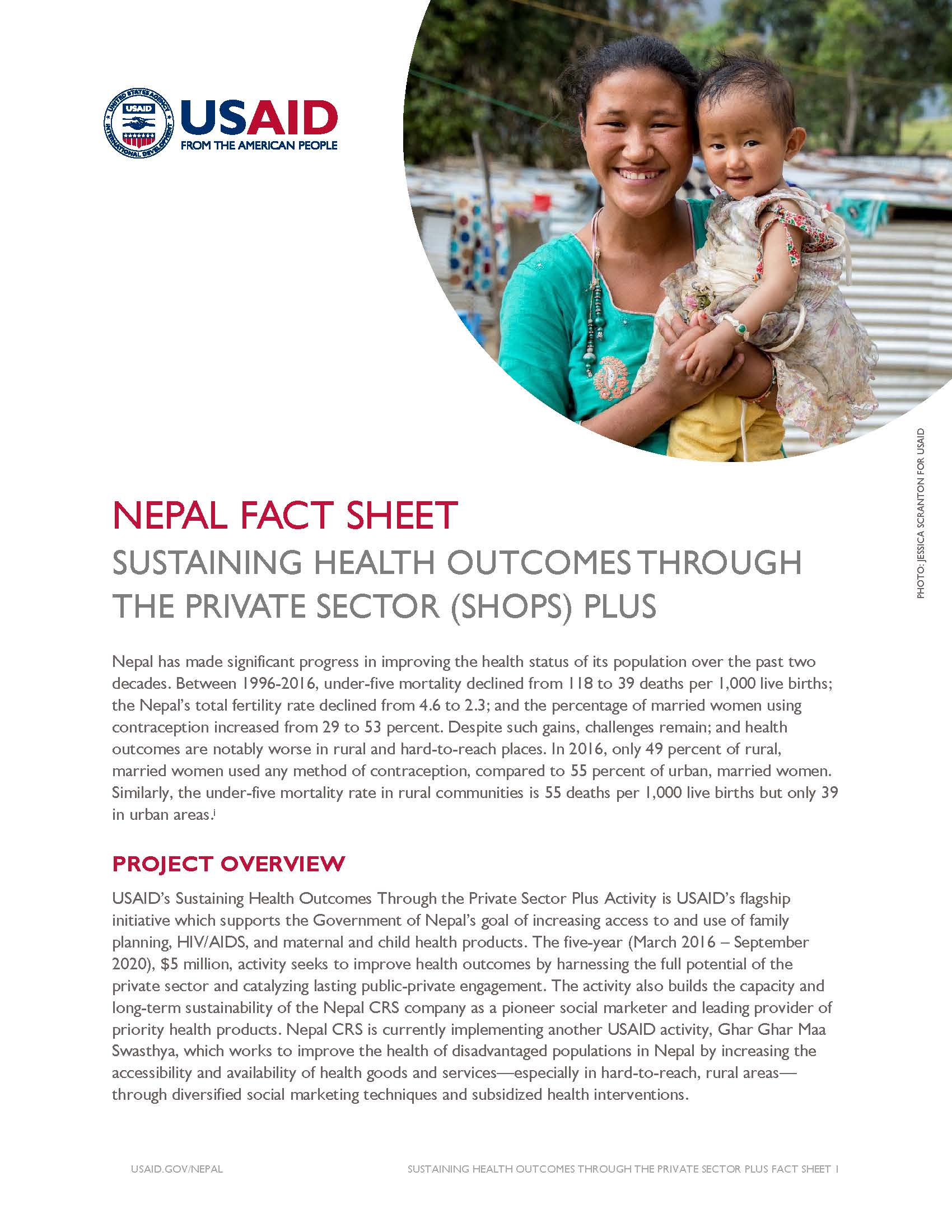Speeches Shim
Nepal has made significant progress in improving the health status of its population over the past two decades. Between 1996-2016, under-five mortality declined from 118 to 39 deaths per 1,000 live births; the Nepal’s total fertility rate declined from 4.6 to 2.3; and the percentage of married women using contraception increased from 29 to 53 percent. Despite such gains, challenges remain; and health outcomes are notably worse in rural and hard-to-reach places. In 2016, only 49 percent of rural, married women used any method of contraception, compared to 55 percent of urban, married women. Similarly, the under-five mortality rate in rural communities is 55 deaths per 1,000 live births but only 39 in urban areas.
PROJECT OVERVIEW
USAID’s Sustaining Health Outcomes Through the Private Sector Plus Activity is USAID’s flagship initiative which supports the Government of Nepal’s goal of increasing access to and use of family planning, HIV/AIDS, and maternal and child health products. The five-year (March 2016 – September 2020), $5 million, activity seeks to improve health outcomes by harnessing the full potential of the private sector and catalyzing lasting public-private engagement. The activity also builds the capacity and long-term sustainability of the Nepal CRS company as a pioneer social marketer and leading provider of priority health products. Nepal CRS is currently implementing another USAID activity, Ghar Ghar Maa Swasthya, which works to improve the health of disadvantaged populations in Nepal by increasing the accessibility and availability of health goods and services—especially in hard-to-reach, rural areas— through diversified social marketing techniques and subsidized health interventions.
PROJECT OBJECTIVE
The activity’s supports a sustained increase in access to, demand for and use of priority health products by improving Nepal CRS’s overall technical capacity and internal efficiency. The activity will achieve this objective by focusing on the following three goals:
- Improving Nepal CRS’s technical sustainability;
- Improving Nepal CRS’s institutional sustainability; and
- Improving Nepal CRS’s financial sustainability.
KEY RESULTS
During the first three years, the activity has accomplished the following:
- Developed a Social Marketing Organization Development Assessment Tool to determine a baseline and assess progress against three measures of organizational sustainability annually;
- Supported Nepal CRS to increase its total score by approximately 15 percent between the first and second annual assessments;
- Enhanced Nepal CRS’s distribution efficiencies and addressed supply gaps;
- Supported Nepal CRS in introducing more rigorous quality assurance processes for providers in its Sangini network—including the use of web-based data collection during supportive supervision to facilitate analysis and feedback to providers;
- Improved CRS’s capacity to design and implement a more intensive approach to community- based behavior change campaigns serving rural communities that make greater use of baseline data, incorporate more intensive training and supervision of community agents and uses a wider range of communications channels, such as radio and events;
- Helped CRS strengthen its human resource function by updating its bylaws, instituting a rigorous time charging system for staff labor, revising the performance appraisal system to link staff performance to program goals and improving accountability;
- Worked with CRS to formalize new business processes and establish an indirect rate to finance fundraising efforts that will ensure financial sustainability through donor diversification; and
- Supported CRS in improving their financial management capabilities by using financial performance indicators and expanding the capacity of CRS’ financial management software to track cost recovery, cost per product sold and other key ratios.


Comment
Make a general inquiry or suggest an improvement.